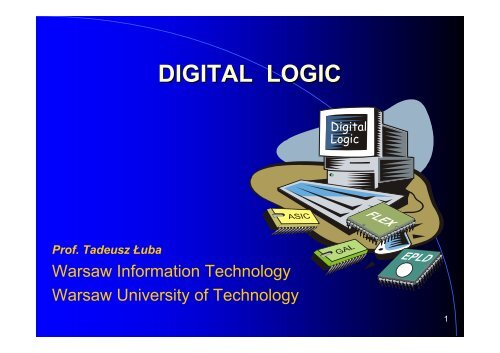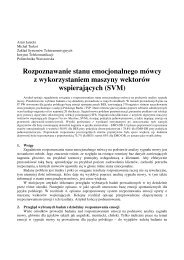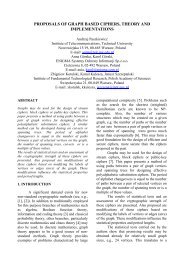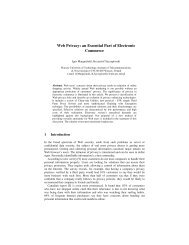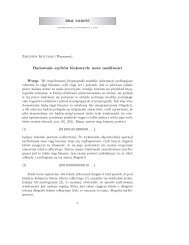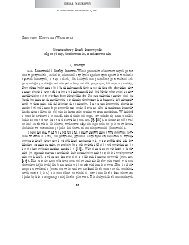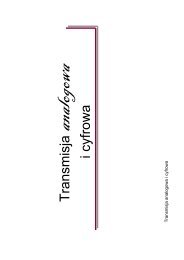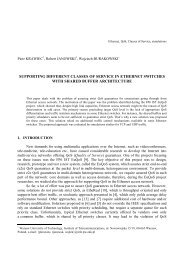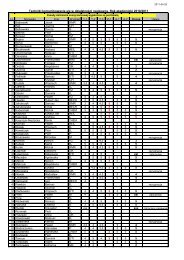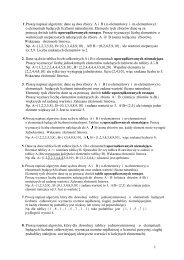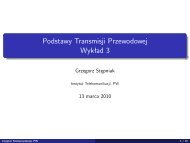DIGITAL LOGIC
DIGITAL LOGIC
DIGITAL LOGIC
You also want an ePaper? Increase the reach of your titles
YUMPU automatically turns print PDFs into web optimized ePapers that Google loves.
<strong>DIGITAL</strong> <strong>LOGIC</strong><br />
/<br />
Digital<br />
Logic<br />
Prof. Tadeusz Łuba<br />
Warsaw Information Technology<br />
Warsaw University of Technology<br />
1
Our communication<br />
0 - 22- 825 -1580<br />
luba@tele.pw.edu.pl<br />
The subject homepage is located at:<br />
http://www.zpt.tele.pw.edu.pl<br />
2
Personal communication<br />
Building of Electronics<br />
Nowowiejska 15/19 str.<br />
room. 472/473<br />
5
Organization of our course<br />
Lecture<br />
General Conclusion<br />
Uniform methodology useful for both<br />
information and logic systems<br />
FPGA- and PLA-based synthesis<br />
Boolean function<br />
Classes<br />
40 points<br />
Exam<br />
60 points<br />
Total<br />
100 points<br />
6
1. Ashar P., Devadas S., Newton A. R.: Sequential logic synthesis,<br />
Kluwer Academic<br />
2. Minimization Algorithms for VLSI Synthesis, Kluwer Academic<br />
Publishers, Boston, 1984.<br />
3. Brown F. M.: Boolean Reasoning. The Logic of Boolean Equation,<br />
Kluwer Academic Publishers, 1990.<br />
4. Brzozowski J. A, Seger C-J.: Asynchronous Circuits, Springer Verlag,<br />
New York 1995.<br />
5. Brzozowski J., Łuba T.: Decomposition of Boolean Functions Specified<br />
by Cubes. Journal of Multiple-Valued Logic and Soft Computing.<br />
Vol. 9, pp. 377–417. Old City Publishing, Inc., Philadelphia 2003.<br />
6. De Micheli G.: Synthesis Lala and Optimization Parag.: of Digital Circuits. McGraw-Hill,<br />
New York, 1994. Również tłumaczenie polskie: Synteza i optymalizacja<br />
układów cyfrowych. WNT, Warszawa 1998.<br />
7. Devadas, S.,<br />
Practical<br />
Ghosh, A., and Keutzer,<br />
Digital<br />
K. Logic Synthesis.<br />
Design<br />
McGraw-Hill,<br />
New York, 1994.<br />
8. Gajski D.D.: Principles of digital and design. Testing.<br />
Prentice-Hall International,<br />
New jersey 1997.<br />
9. Hassoun S., Sasao T., Brayton R. (ed.): Logic Synthesis and Verification.<br />
Kluwer Academic Publishers, Prentice-Hall<br />
New York 2002.<br />
10. Iman S., Pedram M.: Logic Synthesis for Low Power VLSI Design, Kluwer<br />
Academic Publishers, 1999. 1996<br />
11. Kamionka-Mikuła H., Małysiak H., Pochopień B.: Układy cyfrowe. Teoria<br />
i przykłady. Wyd. Pracowni Komputerowej Jacka Skalmierskiego.<br />
Gliwice 2003.<br />
12. Kania D.: Synteza logiczna przeznaczona dla matrycowych struktur<br />
programowalnych typu PAL. Politechnika Śląska. Zeszyty Naukowe.<br />
Nr 1619. Gliwice 2004.<br />
13. Katz R. H.: Contemporary logic design. The Benjamin/Cummings<br />
Publishing Company, Inc., Redwood City, 1994<br />
14. Kohavi Z.: Switching and Finite Automata Theory. Mc-Graw-Hill,<br />
New York, 1978.<br />
15. Kuźmicz W.: Układy ASIC w polskich realiach. Przegląd Telekomunikacyjny<br />
i Wiadomości Telekomunikacyjne, nr 8, pp. 457-460, 1995.<br />
16. Lala P.K.: Practical digital logic design and testing. Prentice-Hall,<br />
New Jersey 1996.<br />
17. Łuba T.(red.), Rawski M., Tomaszewicz P., Zbierzchowski B.: Synteza<br />
układów cyfrowych. WKŁ Warszawa 2003.<br />
18. Łuba T., Zbierzchowski B., Zbysiński P.: Układy reprogramowalne dla<br />
potrzeb telekomunikacji cyfrowej. Przegląd Telekomunikacyjny<br />
i Wiadomości Telekomunikacyjne, nr 5, 2002.<br />
Bibliography<br />
19. Łuba T.: Synteza układów logicznych. Wyższa Szkoła Informatyki<br />
Stosowanej i Zarządzania, Wyd. 2, Warszawa 2001.<br />
20. Łuba T.: Rola i znaczenie syntezy logicznej w technice cyfrowej<br />
układów programowalnych. Elektronika, str. 15 ¸ 19, nr 7-8, 2002.<br />
21. Łuba T., Jasiński K., Zbierzchowski B.: Programowalne układy<br />
przetwarzania sygnałów i informacji - technika cyfrowa<br />
w multimediach i kryptografii, Przegląd Telekomunikacyjny i Wiadomości<br />
Telekomunikacyjne, str. 408-418, nr 8-9, 2003.<br />
22. Majewski W., Albicki A.: Algebraiczna teoria automatów. WNT,<br />
Warszawa 1980.<br />
23. Mikołajczak B.: Algebraiczna i strukturalna teoria automatów. PWN,<br />
Warszawa – Łódź 1985.<br />
24. Mulawka J.: Systemy ekspertowe. WNT, Warszawa 1996.<br />
Łuba T.:<br />
25. Mrózek A., Płonka L.: Analiza danych metodą zbiorów<br />
przybliżonych. Zastosowania w ekonomii, medycynie i sterowaniu.<br />
Akademicka Oficyna Wydawnicza PLJ, Warszawa 1999.<br />
26. McCluskey E. J.: Logic design principles, with emphasis on testable<br />
semicustom circuits. Prentice-hall International, Inc., New Jersey<br />
1986.<br />
27. Pawlak Z.:Rough Sets. Theoretical Aspects of Reasoning about<br />
Data, Kluwer Academic Publishers, 1999.<br />
28. Roth C. H.: Fundamentals of Logic Design. West Publ. CO., 1985.<br />
29. Salsic Z., Smailagic A.: Digital systems design and prototyping<br />
using field programmable logic. Kluwer Academic Publishers, 1997.<br />
30. Sasao T.: Switching Theory for Logic Synthesis, Kluwer Academic<br />
Publishers, 1999.<br />
31. Sasao T.: Logic Synthesis and Optimization. Kluwer Academic<br />
Publishers,1993.<br />
32. Słowiński R.(ed.): Intelligent Decision Support - Handbook of<br />
Applications and Advances of the Rough Sets Theory, Kluwer<br />
Academic Publishers, Dordrecht 1992.<br />
33. Scholl C.: Functional Decomposition with Application to FPGA<br />
Synthesis. Kluwer Academic Publisher, Boston 2001.<br />
34. Tyszer J.: Układy cyfrowe. Materiały pomocnicze do wykładów.<br />
Wyd. Politechniki Poznańskiej. Poznań 2000.<br />
35. Zieliński C.: Podstawy projektowania układów cyfrowych. PWN,<br />
Warszawa 2003.<br />
36. Zbysiński P., Pasierbiński J.: Układy programowalne – pierwsze<br />
kroki. Wyd. II, Wydawnictwo BTC. Warszawa 2004.<br />
Multi-Level Logic Synthesis<br />
Based on Decomposition.<br />
Microprocessors and<br />
Microsystems, vol. 18, No.<br />
8, pp. 429-437, 1994.<br />
7
Textbooks<br />
8
Digital systems are used extensively<br />
in almost every part of human’s life.<br />
Digital system<br />
4<br />
10
. . . Progress of microelectronic<br />
technology<br />
40 mln. transistors<br />
10 mln. gates<br />
ASIC<br />
11
With such a fast growth, the need for<br />
efficient methods for designing digital<br />
systems is essential and puts very high<br />
demands on the education of computer<br />
science and engineering.<br />
Digital logic is a branch of digital technology<br />
providing foundations for digital systems<br />
design.<br />
12
Design flow<br />
Translation Tools<br />
Logic synthesis<br />
Technology mapping<br />
Million<br />
gates<br />
FPGA<br />
13
1984 (Espresso)<br />
Modern logic synthesis<br />
Progress of technology<br />
Two level<br />
synthesis<br />
Multilevel<br />
synthesis<br />
PLA based<br />
synthesis<br />
1990<br />
Symbolic<br />
minimization<br />
Functional<br />
decomposition<br />
1995<br />
14
Syllabus<br />
1. Boolean Algebra.<br />
2. Combinational circuits. Minimization of Boolean expressions.<br />
3. Computer methods for minimization of Boolean functions. Expansion method.<br />
4. Different ways of implementing Boolean expressions.<br />
5. Reduction of input variables. Decomposition of Boolean functions.<br />
6. Sequential circuits synthesis. State diagram of sequential circuit.<br />
7. State assignment. Excitation tables and functions. State reduction.<br />
8. Asynchronous sequential circuits.<br />
9. Complex digital systems. Algorithmic state machine. Design example:<br />
binary to BCD converter.<br />
10. Modern procedures of logical synthesis.<br />
11. Logical synthesis in the analysis of information systems:<br />
in machine learning and knowledge acquisition algorithms.<br />
15


